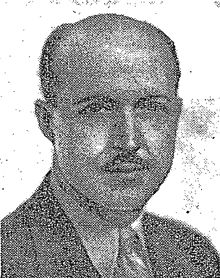Clyde E. Elliott
| Clyde E. Elliott | |
|---|---|

Clyde E. Elliott
|
|
| Born | July 23, 1885 Ord, Nebraska |
| Died | June 12, 1959 (age 73) Los Angeles, California |
| Occupation | motion picture director, producer, and writer |
| Years active | 1919-1947 |
| Spouse(s) | Marie Elliott |
Clyde Ernest Elliott (born July 23, 1885, Ord, Nebraska; died June 12, 1959 (age 73), Los Angeles, California) was a motion picture director, producer, and writer. He is best known for animal films, especially Frank Buck’s first movie, Bring 'Em Back Alive (1932).
Elliott was a class of 1909 alumnus of the University of Nebraska, and was a newspaper reporter, advertising solicitor and advertising promotion manager before entering the motion picture Industry. He founded Post Pictures Corporation in 1919, to make nature films distributed by Paramount.
In Bring ‘Em Back Alive, unlike in most other jungle pictures of the time, Elliott kept the camera in the background. Neither the camera nor the cameramen are visible in any of the scenes. The result is an infinitely clearer conception of the clashes between tigers, pythons and crocodiles than had been achieved in previous films. The movie was a huge hit, Elliott's (and Frank Buck's) most successful and popular film.
In The Devil Tiger (1934), Elliott allowed his star, Kane Richmond, to fight a 25 foot python. Richmond hated snakes but hated doubles more, and had insisted. The actor, on his feet, on the ground, on his feet again, succeeded in holding the snake's snapping mouth away from his face, while struggling to free himself from the triple coils around his body. At the height of the struggle, the heroine, Marion Burns, runs in and saves the hero from the python. Ms Burns had to fight the snake too, in order to get at Richmond's pistol, with which she was supposed to dispatch the python. She played her own scene, as well.
In 1935, Elliott was scheduled to visit Mongolia for Columbia Pictures to produce a film called China Roars. He was to be accompanied by one author (Gordon Rigby), two camera men (Carl Berger and Robert Miller), one assistant director, a business manager, a sound man (Zultan Kagel) and one American actor, whom Elliott hoped would be "a cross between Clark Gable and Ronald Colman." The story concerned an American physician and his Chinese aviator friend who decided to fly over the route to India once followed by Marco Polo. They are forced down in the Gobi Desert, taken prisoner by a nomad tribe, finally escape and, after a series of adventures which include a fight with river pirates, return to Shanghai. This movie was never made.
...
Wikipedia
